The thesis paper has intended to develop a framework of information architecture that can integrate the environment and contextual species that we directly or indirectly co-exist and interact with. It is a mode through which architecture can make sense of the humans and species inhabiting it and respond, according to the experiential metadata decoded by machine learning ability through sound generating a response mechanism that favour equally what exist around us. Adapt even, with every usage to accommodate itself better according to its environment. The fundamental notion on which the whole path progression of inclusion through co-existence with species that needs to take place has been experimented with through this research paper.
Sound as an adhesive that binds people with their space and species to their environment is examined to establish a path that develops individualised and personalised optimisation in architecture without bias.
Ground-breaking Artificial technologies of Spotify Application programming Interface and Google Magenta representational state transfer system are being used to establish links from the different sound of species to behaviour traits to the factor of mood to different needs overlapping with the dimension of time. This response model formulates as a guide to optimise and create changes in space.
Ground-breaking Artificial technologies of Spotify Application programming Interface and Google Magenta representational state transfer system are being used to establish links from the different sound of species to behaviour traits to the factor of mood to different needs overlapping with the dimension of time. This response model formulates as a guide to optimise and create changes in space.
Scope of work
Coding I Training Data sets I Testing metadata I Data structuring I Data conversion I Frequency and amplitude partitioning system I signal processing wavelets I Conversion theory I Correlation Theory I Error predictive analysis I dynamic simulation I writing I Envision new constituencies and economical framework
MEdia and softwares
Rhinoceros 3D, Grasshopper, Lunchbox, kangaroo 3D, 3ds max, Corona Renderer, illustrator, photoshop, Application programming interface of Spotify, Apple Music and google servers, Indesign
Professors Guidance
(Associate Dean) Himanshu Singhani, (Assistant professor) Ramit Naahar, SSAA
2020, Architecture Thesis
Artificial Intelligence-powered dynamic sound model to create responsive and integrated interaction-based multi-species co-existable spaces.
SITE PLAN ORTHOGONAL VIEW
INTERIOR ELEVATION
Sound as a universal language that generates as a result of the first energy expenditure of any species within the context. This is the one and the only thing we all have in common except the m.superstes cell that formed everybody gene circuit and our DNA survival mutational system.
Recognisably sound and musical activities appear to have been present in every known culture on earth, with ancient roots extending back 250,000 years or more. Whether for entertainment, relaxation, spiritual prayer, or anything else, the music finds its way into almost every facet of a species life.
Since our environment contains ecological diversity with mutualism, commensalism, parasitism, neutralism, amensalism, and competition type interactions among biological species within the member of a contextual community. The absence of such primal interaction within, with or interlinked among different species In our (human) prevailing settlement patterns and urban fabric elongates the difference between the diversity and unified neutral theory of existence.
The Audio features were retrieved and analysed to create inferential data modulation from the representational state transfer software through the application programming interface of sound translation network by inputing the soundscape audio units categorising each species of animal that exist in the preliminary site and projected with a response model that can generate a dynamic simulation architecture.
Architectural space is highly influenced by the energy that a space inhabits (Arousal- energy) which includes the different type of activities variation either of high or low intensity that can be performed In and around the space.
The State of emotion that space makes the species feels or is brought with - Experientially (Valence), This becomes highly important to identify by the architectural model as to whether the particular Species is feeling more positive (happy, cheerful, euphoric) or more negative (sad, depressed, angry) while having direct or In-direct interaction.
Every species emit sound signals which has a potential time interval to understand the Eco-location and movement pattern through different interactive state using (loudness and Reverberation Time).
Out of all the audio features, I decided to narrow down and extract only three particular values - Valence(Emotion), Arousal (energy) and loudness, since they have the greatest impact and were the most relatable features in aspect of architecture.
The State of emotion that space makes the species feels or is brought with - Experientially (Valence), This becomes highly important to identify by the architectural model as to whether the particular Species is feeling more positive (happy, cheerful, euphoric) or more negative (sad, depressed, angry) while having direct or In-direct interaction.
Every species emit sound signals which has a potential time interval to understand the Eco-location and movement pattern through different interactive state using (loudness and Reverberation Time).
Out of all the audio features, I decided to narrow down and extract only three particular values - Valence(Emotion), Arousal (energy) and loudness, since they have the greatest impact and were the most relatable features in aspect of architecture.
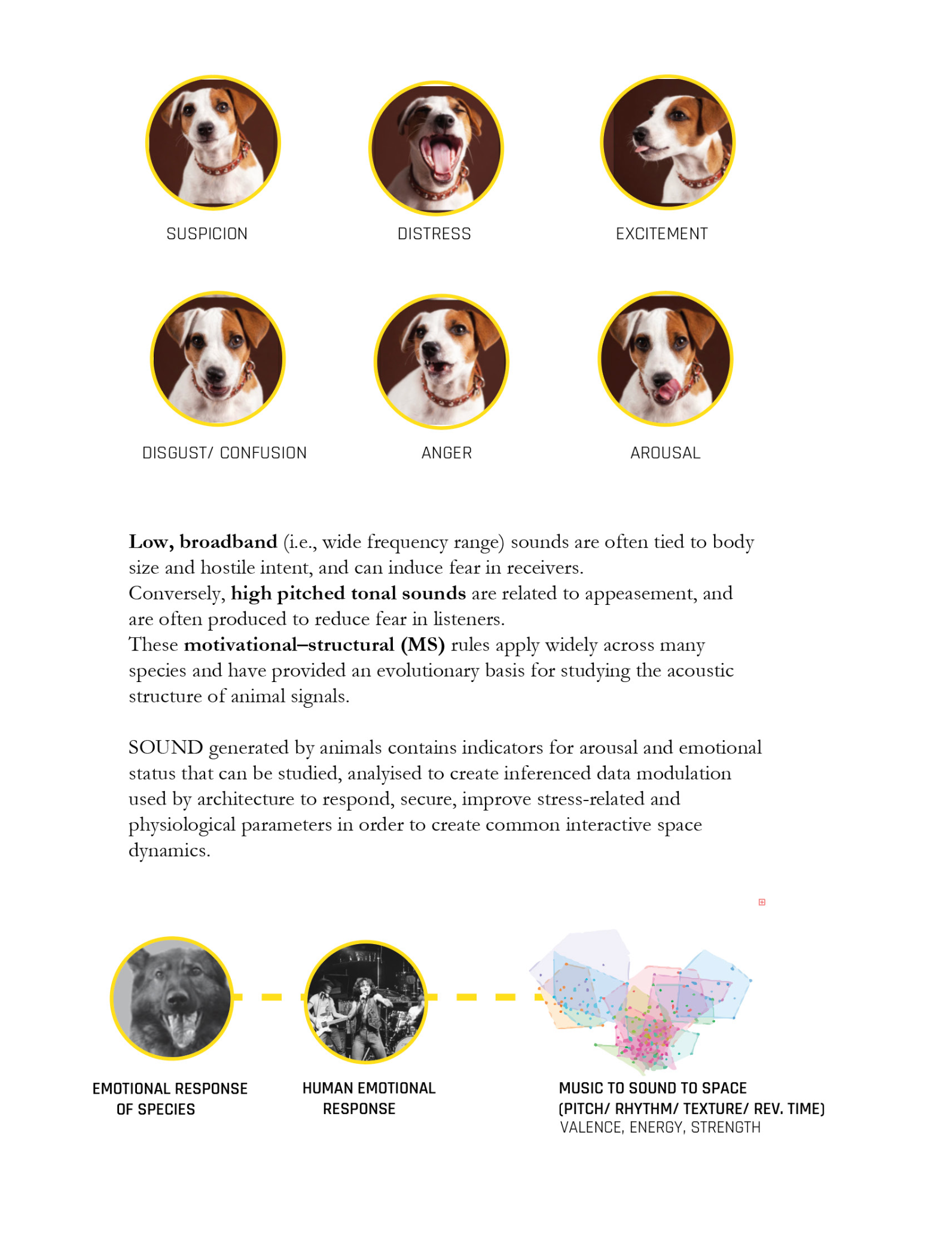
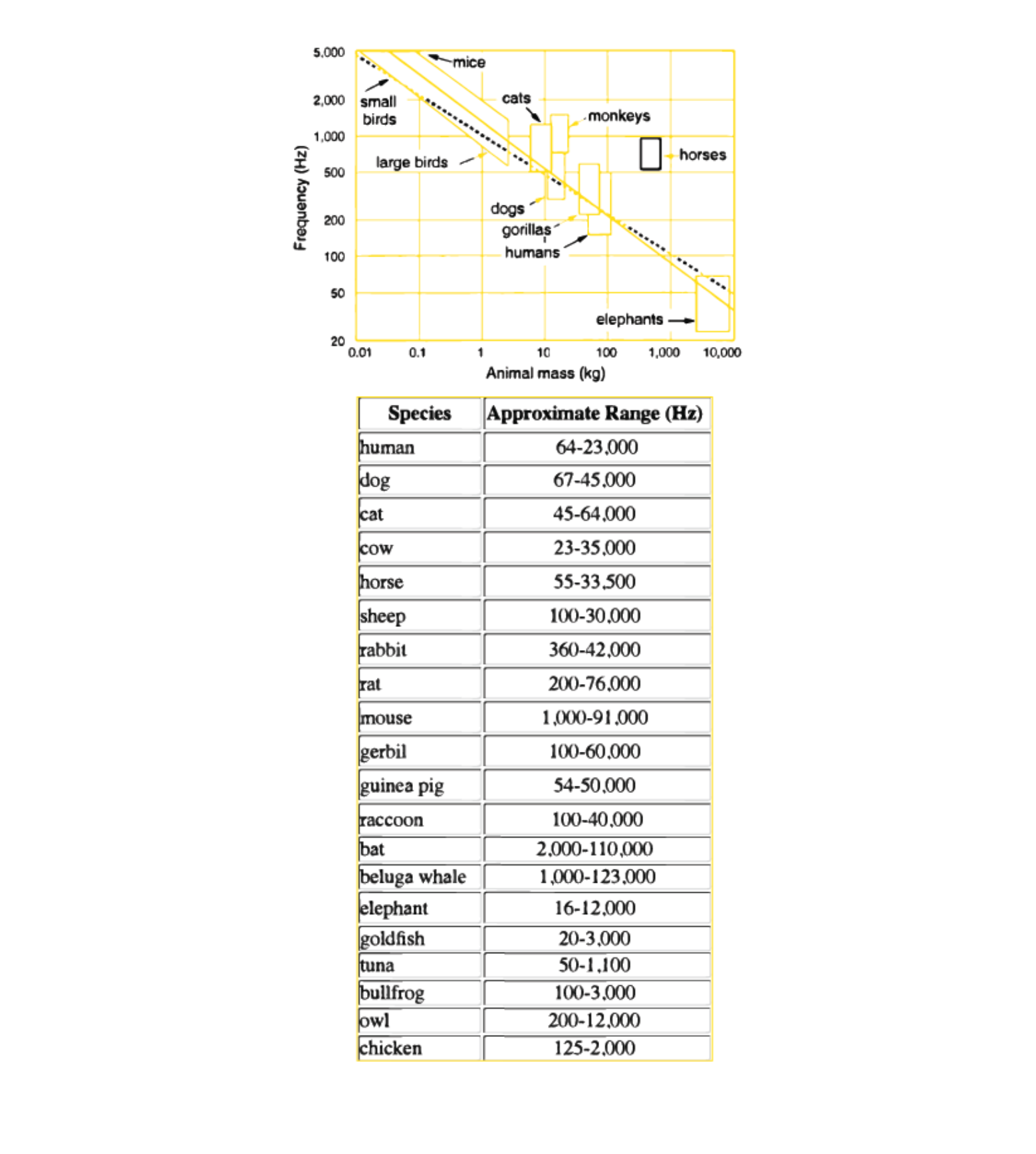
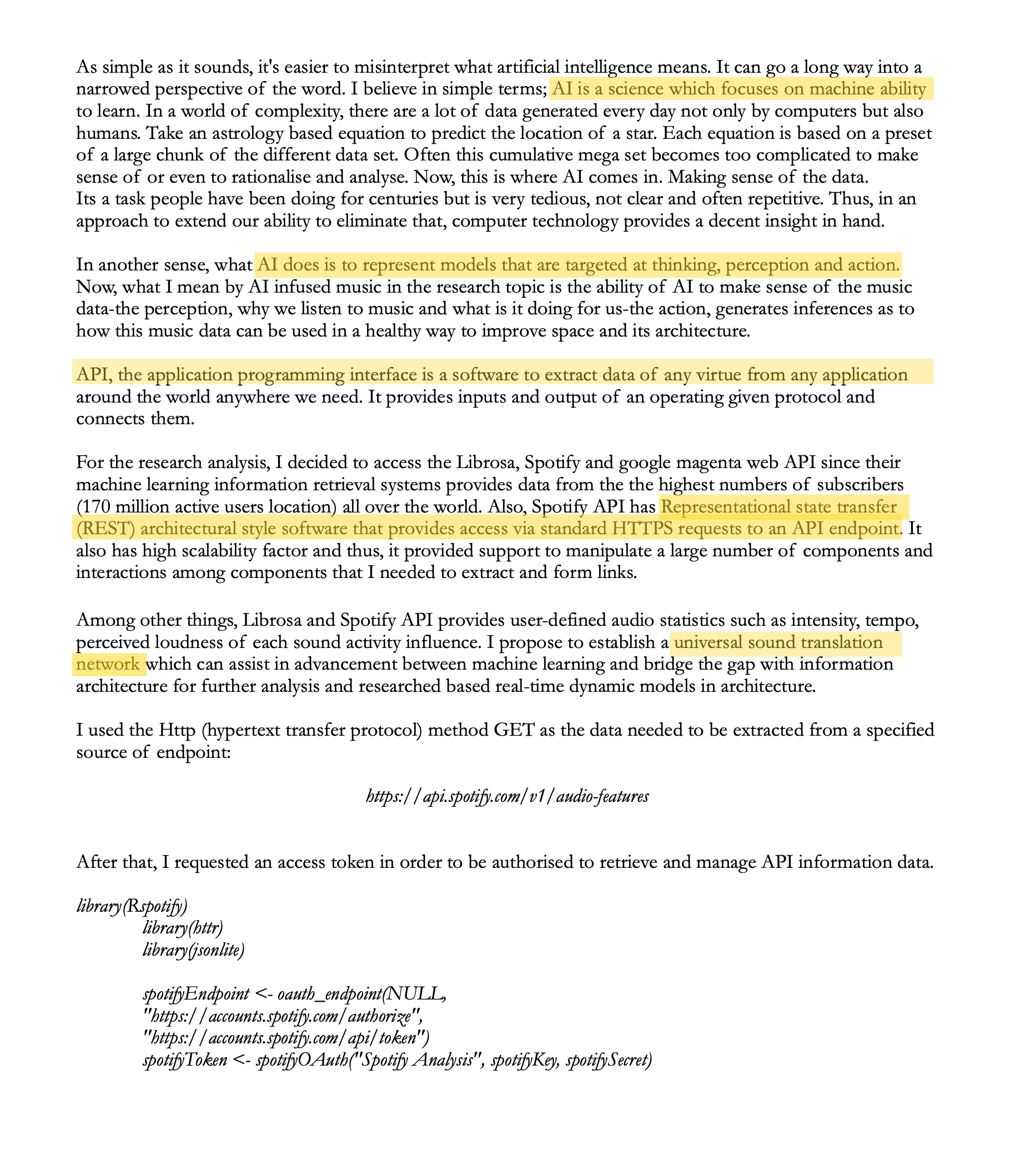

These vectors are projected in a three-dimensional equation with components x-valence, y-energy and z-loudness.
To convert these components in building type and architectural format. Two directions were established and experimented on:
To convert these components in building type and architectural format. Two directions were established and experimented on:
A. Conversion Theory: A method of conversion was experimented, where the decibel value of 0.001 to be equal to 10mm as a base rule for the x-y-z equation.
B. Correlation Theory: breaking down the vector effects into fractions which when applied to an architectural system of any scale can generate results to analyse and conduct further correlation coefficient approach.
The parameter framework developed to generate raw data is based upon spectral and spatial narrowing down of spaces based upon species size, motion, lifetime, spatial temporal heterogeneity and the environmental fluctuation. A universal sound translation network and global resource platform were used to minimise generalised error and predictive proximity errors for which filtration of un-informative variables were done using crude-filtration.
FORM EXPERIMENT
CELL TO MULTI-CELLULAR NETWORK
DATA TO STRUCTURE/ WORKING
Combining artificial Intelligent cognition sounds with the dynamic aspect of architecture involved four unique problems, which were being experimented to solve and achieve a built architecture. First, how will sound be measured to provide input information to the computer system? Second, how will that information be presented to change the dynamics of the space? Third, how will it be represented (the structural system) in such a way that the program can, in some way, come to some understanding of its meaning? And finally, what will be the output of this knowledge?
This progressed the thesis paper to generate further scope of work in respect to the dynamic simulation architectural model based upon AutoML deep learning platforms.
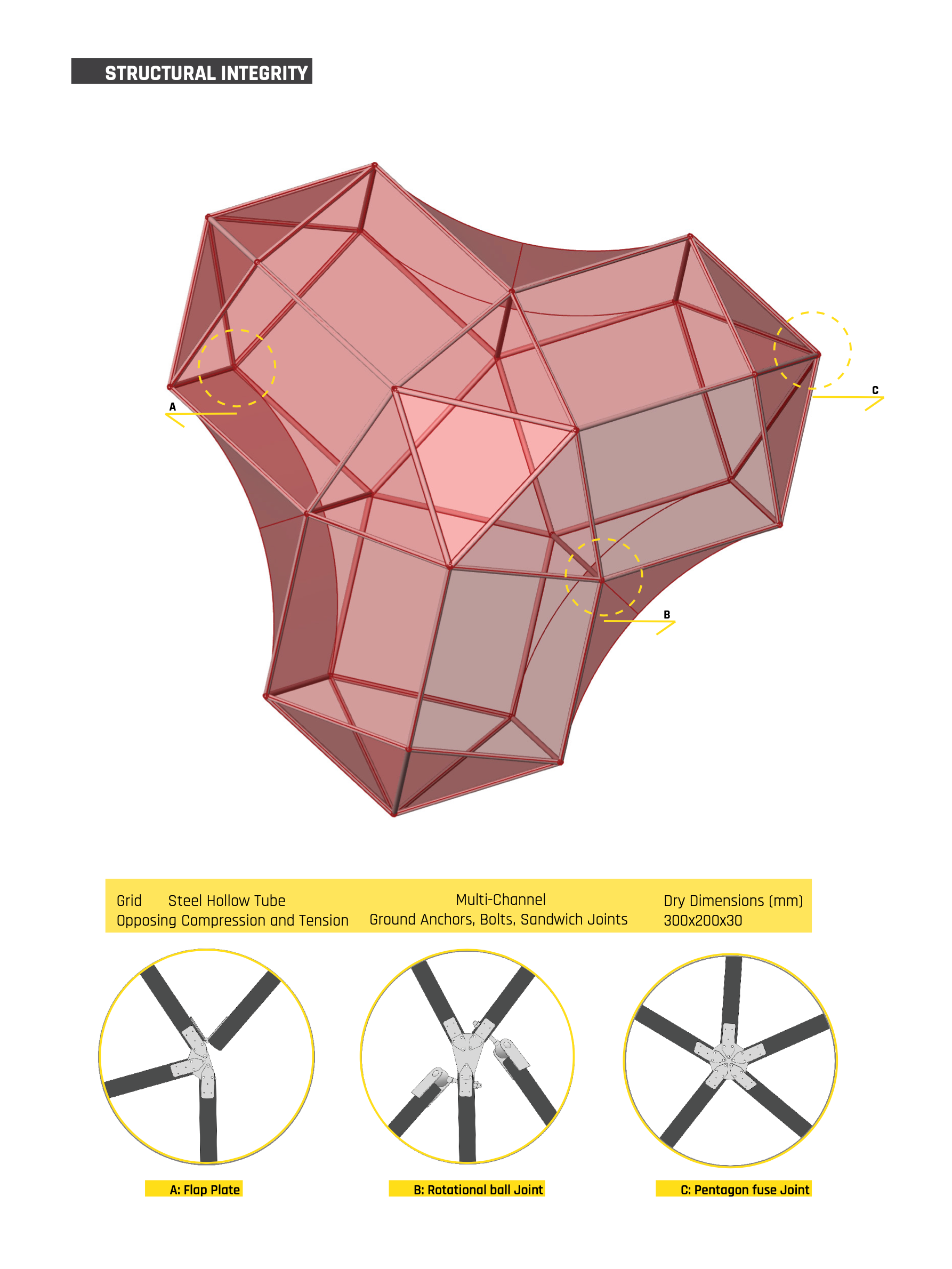
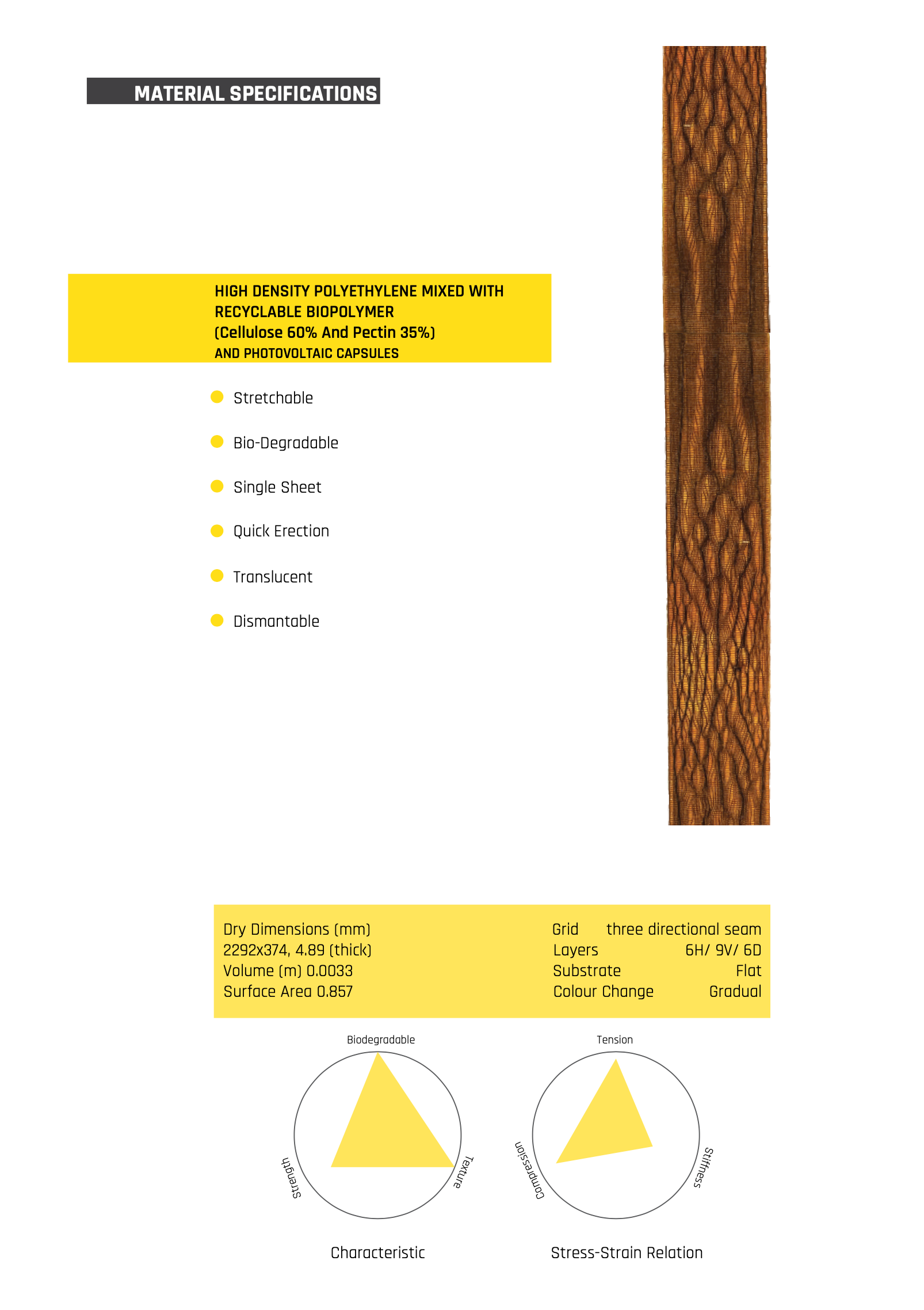
Site/ Hanle/ Ladakh
The site area of the whole town is situated in the heart of the trade and silk route corridor that connects four different countries and region bringing various context, culture, lifestyle, behaviour patterns, habits and species interaction and intersection together.
Situated at an elevation of 9,022-25,171 feet (2,750-7,672 meters) above the sea level along the handle river valley. The site offers rich ecological biodiversity of plants and animal species with Nomad way of life still being practised as a dominant lifestyle.
A site developed along movement and flow of species allow us to have lease Impact on site natural characteristics and hinderance of any-one pre-dominant species: Humans.
The existing social, political, economic fabric allow for a primitive landscape.
Space: (Void + Ma) the soundscape, airspace allow to provide fresh, natural and non-echo values to test extremities and gain filtered meta data for architecture to evolve and change In-sync to its interaction.
All Images, photographs, drawings, videos, gifs and content of this website remain the sole property of Ar. Raunak and may not be use or reproduce without consent.
All rights reserved. Copyright ©